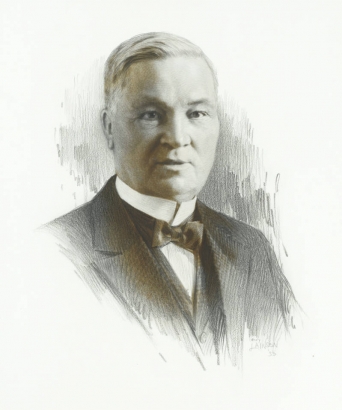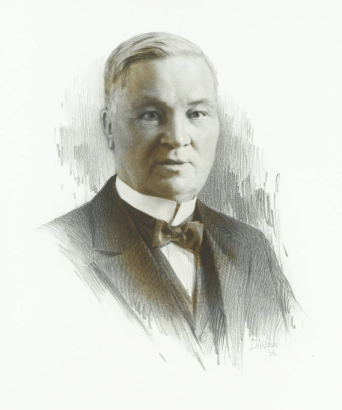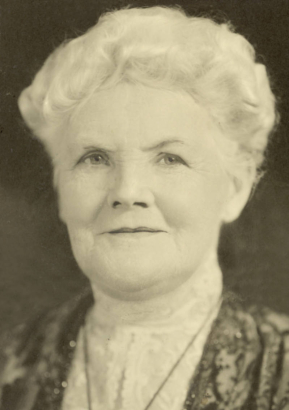Living in Denver, you may have heard the Irish name "Mullen" a few times. There's Mullen High School, the Mullen Home for the Aged, and of course, DPL's Mullen Manuscript Room (Central Library, Level 5).
But who was "Mullen"?
John Kernan Mullen was born in Ballinastoe, County Galway, Ireland in 1847. At the age of nine, he traveled to the United States with his family. They settled in Oriskany Falls, New York. At age fourteen, Mullen dropped out of school to support his family by working at the Oriskany Flour Mill. Before he turned 20 years old, Mullen was managing the mill.
In 1867, Mullen headed out west looking for a miller position. After spending time in Illinois and Atchison, Kansas, he settled in Troy, Kansas, managing the Banner Flour Mills. Three years later, Mullen left for Denver, where he worked for a mill owned by Shackelton and Davis. Mullen married Catherine Smith on October 12, 1874, and together they had five daughters.
In 1875, Mullen decided to operate his own mill and leased the old Star Mill in north Denver as a partnership with Theodore Seth. A year later, Mullen bought Seth out and the company became J.K. Mullen and Company. In the years following, Mullen took over the Iron Clad Mill, Sigler Mill, and Excelsior Mill. He opened the Hungarian Mill in 1882, and the Colorado Milling and Elevator Company in 1885. In addition to milling, Mullen had business interests in land and cattle. These businesses included the J.K. Mullen Land and Cattle Company located in Lamar, the Platte Land and Cattle Company in Logan County; and the Riverside Land and Cattle Company in Larimer County.
Giving numerous donations of land and money, Mullen became known as a philanthropist. Among his most notable gifts:
- Funds for the construction of the J.K. Mullen Memorial Library at Catholic University located in Washington D.C. and a fund to provide ten annual scholarships for Colorado men to the University
- Land and one-quarter million dollars for building the J.K. Mullen Home for the Aged in Denver, presently known as Little Sisters of the Poor Home for the Aged
- Funds for the erection of St. Catejan's Catholic Church
- Major donations for the construction of the Immaculate Conception Cathedral
In 1924, Mullen established the John K. and Catherine S. Mullen Benevolent Corporation. In recognition of Mullen's efforts to help the Catholic Church, Mullen was knighted by the Pope twice (as a Knight of the Order of St. Gregory and a Knight of the Order of Malta).
Mullen died on August 9, 1929, and became the first Roman Catholic to lie in repose at the Cathedral of the Immaculate Conception in Denver. After Mullen's death, his daughters established the Mullen Home for Boys in his memory.
DPL's Western History/Genealogy department holds two archival collections related to J. K. Mullen, including the John K. Mullen & Oscar Malo Collection (WH259) and the J.K. Mullen Foundation Records (WH1201).





Comments
Just curious to see who this
Just curious to see who this man was. Same name.
Thanks for reading, Judy!
Thanks for reading, Judy!
a really great sources of…
a really great sources of information.
a really great sources of…
a really great sources of information.
a really great sources of…
a really great sources of information.
Am interested to know if Mr
Am interested to know if Mr Mullen had any interests in flour or bean elevators / warehouses in southwest Colorado - specifically Dove Creek. There is currently a bean elevator in Dove Creek that has in it's pedigree: Colorado Milling and Elevator Company. Did he have any association with either the Peak or Midland Brands of beans? Could he have had any business interests with a Mr. Owens or a Mr. Simpson from Colorado Springs?
I'm writing a piece on the bean industry.
Thanks.
Yes, Colorado Milling and…
Yes, Colorado Milling and Elevator was Mullen's company.
The statement: "After Mullen
The statement: "After Mullen's death, his daughters established the Mullen Home for Boys in his memory.." is a little bit deceiving. J.K. and Catherine started the project to open a home for orphaned boys, but both died before the project was completed. Their daughters (and husbands) completed the project....the home is now known as Mullen High School. Also, yes, J.K. and Catherine had 5 daughters, but you failed to mention that Anna died at the age of four....
Thank you for your comments,
Thank you for your comments, Katherine. The format of our blog posts calls for brevity and doesn't always allow for the capture of a story's interesting details. Comments like yours really add so much to the story. Thank you!
I am moving into a farmhouse,
I am moving into a farmhouse, that is reputed to be a Mullen homestead.
The property is just north of Mullen High School.
The story is, the house and hundred year old barn ( which I saved despite a large fire)
sat at the center of a large dairy farm.
Love to know more about this history.
The address is 3425 S Knox Ct
Add new comment